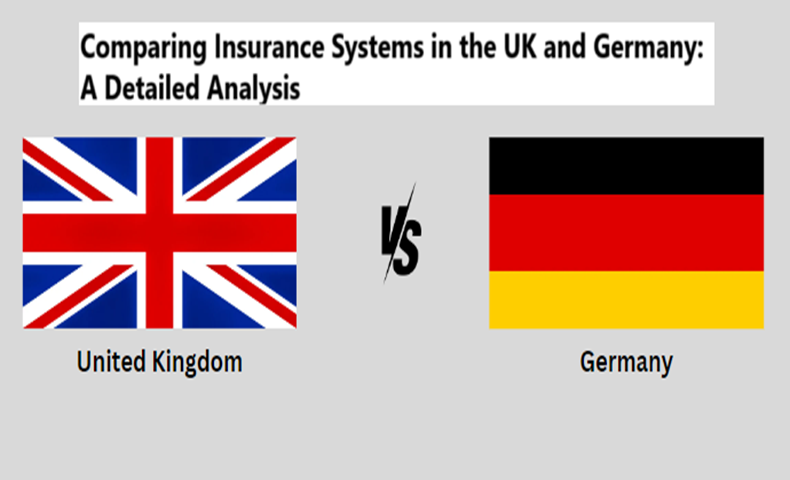Comparing Insurance Systems in the UK and Germany: A Detailed Analysis
Health and social insurance are essential components of social welfare in any country, with different nations adopting varying approaches to ensure that their citizens are covered. In Europe, the UK and Germany offer distinct models of insurance that reflect their political, cultural, and economic contexts. This article provides a comprehensive analysis of the insurance systems in the UK and Germany, focusing primarily on health insurance while also touching on other types of coverage such as unemployment and pension schemes.
1. Historical Background and Foundations
UK Insurance System:
The UK’s health insurance system is predominantly public and is embodied in the National Health Service (NHS), which was established in 1948. The NHS offers healthcare services that are free at the point of use and is primarily funded through taxation. All residents in the UK are automatically covered under the NHS, and there is no need for individuals to purchase health insurance to access basic healthcare services.
The UK’s welfare model is based on a Beveridgean system, named after economist William Beveridge, which advocates for universal healthcare and state intervention to provide social protection. The NHS is considered one of the UK’s proudest public achievements, but it has faced ongoing challenges in terms of funding, staffing shortages, and long waiting times for certain treatments.
German Insurance System:
Germany, on the other hand, operates under a Bismarckian social insurance model. Its healthcare system is based on statutory health insurance (Gesetzliche Krankenversicherung – GKV), which dates back to 1883. German health insurance is mandatory, with most citizens enrolling in one of the numerous statutory health insurance funds. There is also the option for high-income earners and the self-employed to opt out of the public system and take out private health insurance (Private Krankenversicherung – PKV).
The Bismarckian model is characterized by contributions from both employers and employees, and healthcare is predominantly funded through payroll taxes, rather than direct taxation. This system encourages a more decentralized management of healthcare, with a mix of public and private providers working in parallel.
2. Funding and Costs
UK (NHS):
The NHS is largely funded through general taxation, meaning that it is a single-payer system. As a result, it offers universal coverage, and there are no premiums for basic healthcare services. Citizens pay through taxes based on their income, and the NHS budget is managed by the government. Prescription drugs are not entirely free, though they are heavily subsidized, and some groups, such as the elderly and low-income families, are exempt from prescription charges.
The UK system emphasizes cost control and equity, with healthcare access based on need rather than ability to pay. However, this centralized funding model can sometimes lead to budgetary pressures, especially during economic downturns. As a result, the NHS has been criticized for long waiting lists and delays in access to certain services.
Germany (GKV/PKV):
In contrast, Germany’s healthcare system is based on a dual system. Most citizens (around 90%) are enrolled in public health insurance, which is funded through contributions from employers and employees. These contributions are typically a percentage of income, meaning higher earners pay more. The system ensures a high level of care, with a wide range of services covered, including specialist visits, hospital stays, and prescription medication.
Those who opt for private health insurance usually face higher premiums but have more flexibility in choosing doctors and receiving treatments. Private insurance tends to offer shorter waiting times and additional perks, but it can become more expensive over time, especially for the elderly.
The German system is designed to offer choice and competition, with both public and private insurance coexisting. This contributes to a more efficient healthcare system, but it also means that wealthier individuals often receive faster or higher-quality care than those on public insurance.
3. Healthcare Delivery and Access
UK (NHS):
Healthcare in the UK is generally delivered through publicly-owned hospitals and clinics. GPs (general practitioners) serve as the primary point of contact for most patients and act as gatekeepers for specialist services. This system is designed to be both efficient and equitable, but it can sometimes lead to bottlenecks, particularly for non-urgent treatments.
Patients have little to no choice regarding their healthcare provider, which contrasts with more market-driven systems. Despite its limitations, the NHS is valued for its universal coverage, and surveys consistently show high levels of public support for the system.

Germany (GKV/PKV):
In Germany, healthcare is delivered through a mix of public and private providers, with citizens free to choose their doctors, hospitals, and insurance plans. This model offers patients a high degree of autonomy, but it can lead to disparities in care between public and private patients, particularly in terms of waiting times and access to certain specialists.
Germany’s healthcare delivery is marked by a pluralistic approach, with services provided by a variety of healthcare professionals, hospitals, and organizations. This approach fosters competition and efficiency, though critics argue it can sometimes prioritize profit over patient care.
4. Social Security and Other Insurance
UK:
In addition to healthcare, the UK provides various forms of social insurance, including unemployment benefits, pensions, and disability insurance. These are largely managed by the government and are funded through National Insurance contributions from both employers and employees. While these schemes offer a safety net, there have been concerns about the adequacy of benefits, particularly in light of recent austerity measures.
Germany:
Germany’s social security system is comprehensive and covers a wide range of risks, including health, unemployment, pensions, and long-term care. Like healthcare, the system is funded through social contributions, with benefits linked to income. Germany’s pension system is regarded as one of the strongest in Europe, and its unemployment benefits are relatively generous, providing financial security for those out of work.
5. Key Differences and Challenges
One of the main differences between the UK and Germany’s insurance systems is the level of state control. The UK’s NHS is a centralized system, funded and managed by the government, which ensures equity but can struggle with efficiency. Germany’s system is more decentralized, with a mix of public and private players, which promotes competition but can lead to inequalities in care.
A major challenge facing both countries is sustainability. The UK’s NHS faces chronic underfunding and increasing demand, leading to calls for reform. Germany’s healthcare system, while more efficient, is expensive, and there are concerns about the long-term affordability of private insurance for aging populations.
Conclusion
The insurance systems in the UK and Germany offer valuable insights into how different models can address healthcare needs. While the UK’s NHS prioritizes equity and universal coverage, Germany’s mixed model offers more flexibility and choice, albeit at the risk of increasing disparities. Both systems face challenges related to cost, efficiency, and demographic change, but they remain two of the most effective and admired healthcare systems in Europe.
Understanding these systems’ strengths and weaknesses is critical for policymakers and individuals alike as they navigate the future of social insurance.
